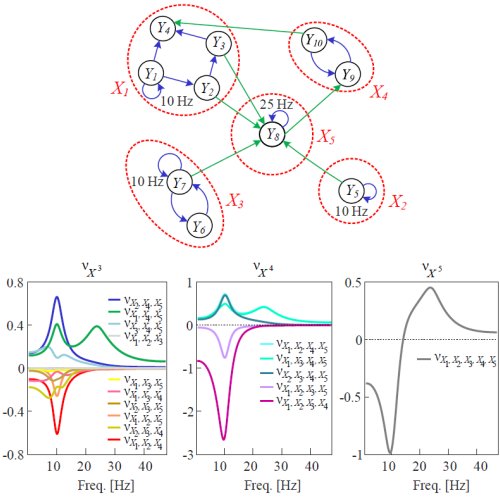OIR - parametric computation of high-order interactions
A Framework for the Time- and Frequency-Domain Assessment of High-Order Interactions in Brain and Physiological Networks
While the standard network description of complex systems is based
on quantifying the link between pairs of system units, higher-order
interactions (HOIs) involving three or more units often play a major
role in governing the collective network behavior.
This toolbox introduces an approach to quantify pairwise and HOIs for
multivariate rhythmic processes interacting across multiple time
scales. The toolbox computes the so-called O-information rate (OIR) as
a new metric to assess HOIs for multivariate time series, and
implements several functions to decompose the OIR into measures
quantifying Granger-causal and instantaneous influences, as well as to
expand all measures in the frequency domain. The framework exploits the
spectral representation of vector autoregressive and state-space models
to assess the synergistic and redundant interaction among groups of
processes, both in specific bands of biological interest and in the
time domain after whole-band integration.
The toolbox contains both simulations showing how the spectral OIR can
highlight redundant and synergistic HOIs emerging at specific
frequencies, which cannot be detected using time-domain measures, and
exemplary applications to physiological time series, i.e. heart period,
arterial pressure and respiration variability measured in a healthy
subject during a protocol of paced breathing, and electrocorticographic
signals acquired in an animal experiment during anesthesia.
The proposed framework allows a hierarchically-organized evaluation of
time- and frequency-domain interactions in dynamic networks mapped by
multivariate time series, and its high flexibility and scalability make
it suitable for the investigation of networks beyond pairwise
interactions in neuroscience, physiology and many other fields.

DOWNLOAD: Zip file with all scripts and functions: OIR.zip
The code is provided free of charge. It is neither exhaustively tested
nor particularly well documented. The authors accept no liability for
its use. Use, modification and redistribution of the code is allowed in
any way users see fit. Authors ask only that authorship is acknowledged
and ref. [1] is cited upon utilization of the code in integral or
partial form.
DISCLAIMER OF
WARRANTIES AND LIMITATION OF LIABILITY The code is supplied as is and
all use is at your own risk. The authors disclaim all warranties of any
kind, either express or implied, as to the softwares, including, but
not limited to, implied warranties of fitness for a particular purpose,
merchantability or non - infringement of proprietary rights. Neither
this agreement nor any documentation furnished under it is intended to
express or imply any warranty that the operation of the software will
be error - free. Under no circumstances shall the authors of the
softwares provided here be liable to any user for direct, indirect,
incidental, consequential, special, or exemplary damages, arising from
the software, or user' s use or misuse of the softwares. Such
limitation of liability shall apply whether the damages arise from the
use or misuse of the data provided or errors of the software.
Reference - Open Access Paper:
L Faes, L Faes, G Mijatovic, Y Antonacci, R Pernice, C Barą, L Sparacino, M Sammartino, A Porta, D Marinazzo, S Stramaglia, 'A new framework for the time- and frequency-domain assessment of high-order interactions in networks of random processes', IEEE Transactions on Signal Processing, 2022; 70: 5766-5777; DOI: 10.1109/TSP.2022.3221892